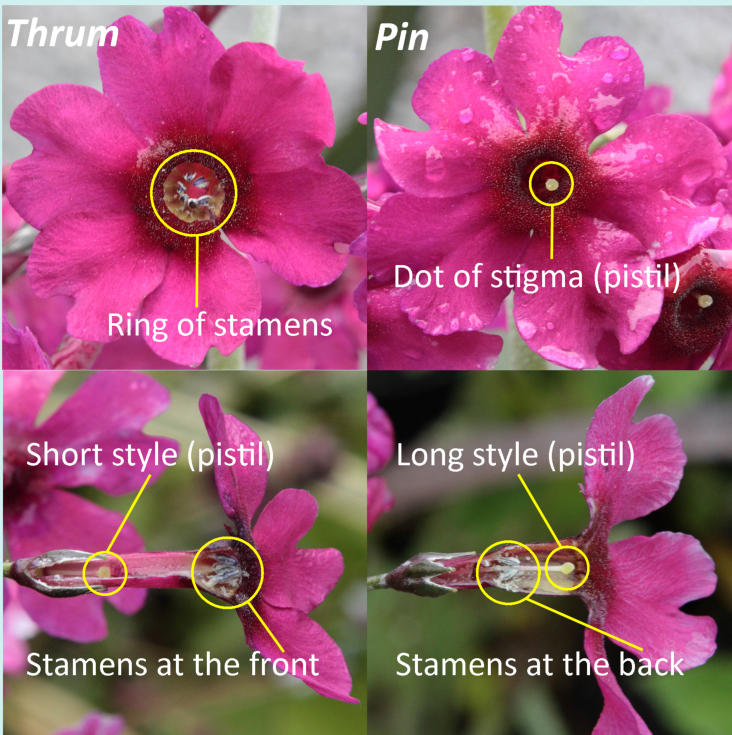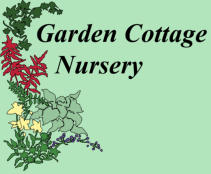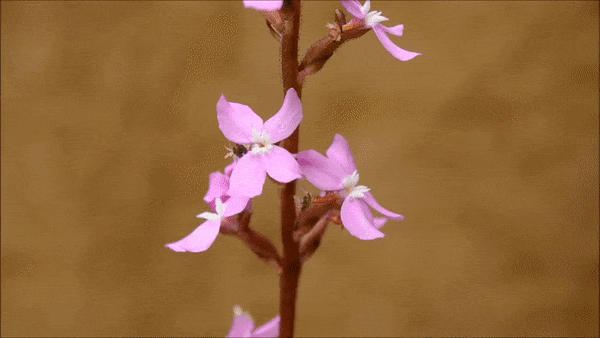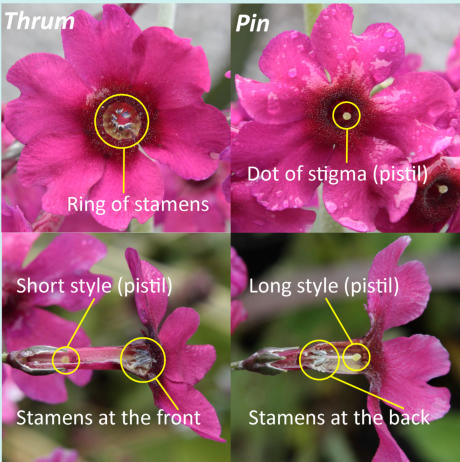
© Garden Cottage Nursery, 2022

All life is basically selfish, if a plant is offering you sweet, sweet nectar in return for hauling around their sticky, heavy pollen for
them why not try to just rob the nectar without getting coated in pollen?
Some plants have taken a novel approach to getting insects to carry their pollen to another flower. Above is a short clip with the
Australian perennial ‘trigger plant’, Stylidium graminifolium, and a pencil tip playing the role of a bee. If you watch closely when the
“bee” lands on the flower the spring loaded floral column containing the stamens and stigma pings around to hit the pollinator on
the back and deposit some of it’s pollen there, it then slowly resets ready for another visitor within a few minutes.

The whole reason flowering plants going to such lengths and expending so much of their resources on producing flowers is to
enable sexual reproduction or meiosis. Meiosis involves cell division, but rather than normal asexual cell division (mitosis) it
involves two different (genetically distinct) cells combining their chromosomes to make an entirely new cell that is genetically half
one parent and half the other, plus a tiny smattering of translation errors known as mutations. If these mutations, along with the
inherited traits provided by both parents, provide a competitive advantage to the offspring then it is itself more likely to ‘find a mate’.
Through succeeding generations the beneficial mutation that first occurred with it’s genesis will likely disseminate, that is evolution
by means of natural selection, see DARWIN, C. (1859) On the Origin of Species. London: John Murray.
Without mutation there is no change in a genome, so no generational adaptation. There is a small chance of each gene mutating in
every cell division, both in meiosis and mitosis type divisions.
Without meiosis there is no way to broadcast advantageous mutation beyond simple duplication. All English elms were raised from
cuttings and were therefore genetically identical, this lead them to all be equally genetically susceptible when Dutch elm disease
struck England. Ergo sex is good, though here in the Roman Catholic endorsed sense; procreative, the evolutionary merits of
recreational plant sex is a different subject entirely.
So both you and almost all of the plants in your garden that were seed-raised are the result of meiosis, plants raised from cuttings
or division are genetically identical to their parent plant, so are the result of mitotic cell division. Meiosis increases genetic diversity
and drives evolution, this is vital to a species ability to adapt and survive, particularly against pathogens and parasites as well as
breeding-out harmful mutations.

Being reliant on other organisms like bees or wind to pollinate their flowers and allow seed production plants have little choice over
their sexual partners (insert own joke here about people from the remote community of your choice here), as such self-pollination in
plants can be a particular problem for them (repeat joke as required, elaborate with additional aspersions about livestock
proclivities and spurious use for broadening of gene pool/biodiversity with allusions to The Wicker Man).
Some plants have evolved specific mechanisms to ensure their flowers are pollinated with pollen from different plants to ensure
that seeds produce will be distinct from the seed parent and not be inbred chinless-wonders. These mechanisms maybe
morphological and/or genetic.
It is due to genetic pollen incompatibilities that many apples and fruiting cherries need a separate pollinator varieties to bare fruit.
One of the most interesting and relevant to gardeners, but little known, of these out-breeding mechanism is heterostyly in Primula.
Primula (including primroses and polyanthus) are unusual in being heterostylous, which means that plants may have their flowers
‘plumbing’ in one of two ways: “Pin”, with the female pistil prominent at the front of the flower, like a pin, and the male stamens
tucked away near the back, or “thrum”, with the arrangement reversed.
The pollen deposited on a bee from one type of flower will be in a more likely position to rub off on the stigma of the other type.
Heterostyly along with genetic pollen incompatibilities help ensure that individual plants don’t self-fertilise.
So a pin plant must be pollinated by pollen from a thrum plant and vice-versa.
If buying a Primula that isn’t already in flower to have a statistically good chance of you having seed baring plants you should buy
at least three plants of the same sort as there is a 50/50 chance that any individual plant will be pin or thrum flowered. The same
‘buy three rule to be safe’ applies to dioecious (separate male and female plants, e.g. holly, Aciphylla and Tasmaniana), plants that
are un-sexed where you will often need a pollinating male plant to ensure fruits are formed on a female.

“Thrum” and “Pin” flowers on Primula pulverulenta. growing side-by-side.
The differing placement of the male and female sexual parts help ensure pollen from the stamens of
one flower type is more likely to reach the stigma of the other.
Thrum flowers will leave pollen on the back of a bee, which will rub off on the stigma of a pin flower
when it is rooting around for nectar at the base of the flower, where it will also get pollen on it’s face,
that will rub off on stigma of the next thrum flower it visits.
P.S. Plant sexual anatomical nomenclature for those who don’t know remember it from biology class in
school:
Male parts: Stamens; consisting of Anthers covered in pollen on stalks called Filaments.
Female parts: Pistil; consisting of a Stigma at the end where the pollen grain is meant to land and a
stalk called a Style, which leads to the Carpel or ovaries.

Why Plants Have Flower
Pollinators





© Garden Cottage Nursery, 2021

All life is basically selfish, if a plant is offering you sweet, sweet
nectar in return for hauling around their sticky, heavy pollen for
them why not try to just rob the nectar without getting coated in
pollen?
Some plants have taken a novel approach to getting insects to
carry their pollen to another flower. Above is a short clip with the
Australian perennial ‘trigger plant’, Stylidium graminifolium, and
a pencil tip playing the role of a bee. If you watch closely when
the “bee” lands on the flower the spring loaded floral column
containing the stamens and stigma pings around to hit the
pollinator on the back and deposit some of it’s pollen there, it
then slowly resets ready for another visitor within a few minutes.

The whole reason flowering plants going to such lengths and
expending so much of their resources on producing flowers is to
enable sexual reproduction or meiosis. Meiosis involves cell
division, but rather than normal asexual cell division (mitosis) it
involves two different (genetically distinct) cells combining their
chromosomes to make an entirely new cell that is genetically
half one parent and half the other, plus a tiny smattering of
translation errors known as mutations. If these mutations, along
with the inherited traits provided by both parents, provide a
competitive advantage to the offspring then it is itself more likely
to ‘find a mate’. Through succeeding generations the beneficial
mutation that first occurred with it’s genesis will likely
disseminate, that is evolution by means of natural selection, see
DARWIN, C. (1859) On the Origin of Species. London: John
Murray.
Without mutation there is no change in a genome, so no
generational adaptation. There is a small chance of each gene
mutating in every cell division, both in meiosis and mitosis type
divisions.
Without meiosis there is no way to broadcast advantageous
mutation beyond simple duplication. All English elms were
raised from cuttings and were therefore genetically identical, this
lead them to all be equally genetically susceptible when Dutch
elm disease struck England. Ergo sex is good, though here in
the Roman Catholic endorsed sense; procreative, the
evolutionary merits of recreational plant sex is a different subject
entirely.
So both you and almost all of the plants in your garden that
were seed-raised are the result of meiosis, plants raised from
cuttings or division are genetically identical to their parent plant,
so are the result of mitotic cell division. Meiosis increases
genetic diversity and drives evolution, this is vital to a species
ability to adapt and survive, particularly against pathogens and
parasites as well as breeding-out harmful mutations.

Being reliant on other organisms like bees or wind to pollinate
their flowers and allow seed production plants have little choice
over their sexual partners (insert own joke here about people
from the remote community of your choice here), as such self-
pollination in plants can be a particular problem for them (repeat
joke as required, elaborate with additional aspersions about
livestock proclivities and spurious use for broadening of gene
pool/biodiversity with allusions to The Wicker Man).
Some plants have evolved specific mechanisms to ensure their
flowers are pollinated with pollen from different plants to ensure
that seeds produce will be distinct from the seed parent and not
be inbred chinless-wonders. These mechanisms maybe
morphological and/or genetic.
It is due to genetic pollen incompatibilities that many apples and
fruiting cherries need a separate pollinator varieties to bare fruit.
One of the most interesting and relevant to gardeners, but little
known, of these out-breeding mechanism is heterostyly in
Primula.
Primula (including primroses and polyanthus) are unusual in
being heterostylous, which means that plants may have their
flowers ‘plumbing’ in one of two ways: “Pin”, with the female
pistil prominent at the front of the flower, like a pin, and the male
stamens tucked away near the back, or “thrum”, with the
arrangement reversed.
The pollen deposited on a bee from one type of flower will be in
a more likely position to rub off on the stigma of the other type.
Heterostyly along with genetic pollen incompatibilities help
ensure that individual plants don’t self-fertilise.
So a pin plant must be pollinated by pollen from a thrum plant
and vice-versa.
If buying a Primula that isn’t already in flower to have a
statistically good chance of you having seed baring plants you
should buy at least three plants of the same sort as there is a
50/50 chance that any individual plant will be pin or thrum
flowered. The same ‘buy three rule to be safe’ applies to
dioecious (separate male and female plants, e.g. holly, Aciphylla
and Tasmaniana), plants that are un-sexed where you will often
need a pollinating male plant to ensure fruits are formed on a
female.

“Thrum” and “Pin” flowers on Primula pulverulenta. growing
side-by-side.
The differing placement of the male and female sexual parts
help ensure pollen from the stamens of one flower type is more
likely to reach the stigma of the other.
Thrum flowers will leave pollen on the back of a bee, which will
rub off on the stigma of a pin flower when it is rooting around
for nectar at the base of the flower, where it will also get pollen
on it’s face, that will rub off on stigma of the next thrum flower it
visits.
P.S. Plant sexual anatomical nomenclature for those who don’t
know remember it from biology class in school:
Male parts: Stamens; consisting of Anthers covered in pollen
on stalks called Filaments.
Female parts: Pistil; consisting of a Stigma at the end where
the pollen grain is meant to land and a stalk called a Style,
which leads to the Carpel or ovaries.

Why Plants Have Flower
Pollinators




















